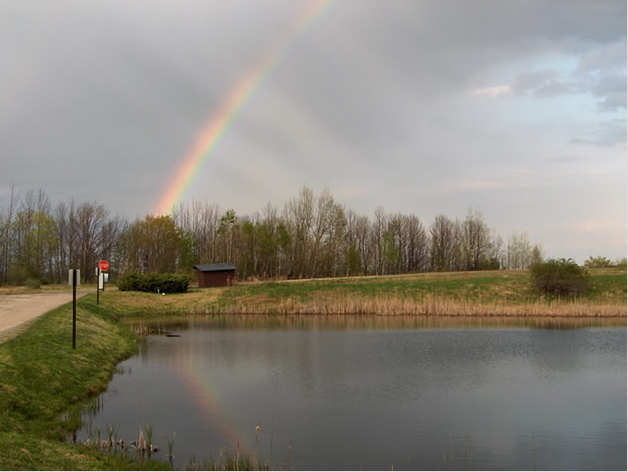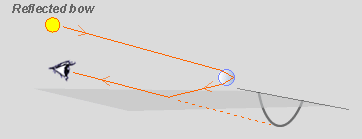Reflection Rainbows
Reflection Rainbows: A Closer Look at Nature's Illusion
Rainbows have always captivated our imagination with their vibrant colors and ethereal beauty. We often associate them with rain showers and sunlight, but there is more to these atmospheric phenomena than meets the eye. In this article, we will delve deeper into the fascinating world of reflection rainbows, shedding light on their formation, characteristics, and the optical illusions they create.
What are Reflection Rainbows?
Contrary to popular belief, reflection rainbows are not actual reflections of their counterparts. Rainbows, being purely optical phenomena, cannot produce reflections. Instead, reflection rainbows are formed by rays of light that pass through raindrops and are then reflected off the water surface before reaching our eyes.
The Inverted Illusion
One striking feature of reflection rainbows is their inverted appearance. The reflection inverts the rainbow, causing the bow's center to appear above the horizon at a point known as the anthelic point. This inversion creates a captivating visual illusion where the reflection bow and the ordinary bow meet in a cusp at the horizon.
The Role of Different Raindrops
It's important to note that the raindrops responsible for forming the reflection rainbow are different from those that produce the sky bow. Each set of raindrops has its own unique characteristics, leading to variations in color intensity and overall appearance. The reflection rainbow below the horizon is created by raindrops that have distinct properties from those forming the sky bow.
Factors Influencing Reflection Rainbows
Several factors come into play when it comes to the formation and visibility of reflection rainbows. These include:
- Sun Angle: The angle at which sunlight strikes the raindrops affects the position and visibility of the reflection rainbow.
- Water Surface Conditions: The smoothness or roughness of the water surface can impact the clarity and brightness of the reflection rainbow.
- Raindrop Size: The size of the raindrops determines the size and intensity of the reflection rainbow.
- Atmospheric Conditions: The overall atmospheric conditions, such as humidity and air density, can also influence the visibility of reflection rainbows.
The Delicate Dance of Light
To fully understand the mesmerizing dance of light that gives rise to reflection rainbows, let's take a closer look at the step-by-step process:
- Sunlight passes through raindrops suspended in the air.
- The light undergoes refraction, bending as it enters and exits the raindrop.
- Some of the refracted light is internally reflected within the raindrop.
- The reflected light then exits the raindrop and strikes the water surface.
- Upon reaching the water surface, the light undergoes reflection.
- The reflected light travels back towards our eyes, creating the illusion of a reflection rainbow.
The Science Behind the Beauty
Reflection rainbows, like their counterparts, are a result of the dispersion of light. When sunlight passes through raindrops, it gets separated into its component colors due to the varying angles at which each color refracts. This dispersion leads to the vibrant array of colors we see in a reflection rainbow.
Capturing the Magic
Photographing reflection rainbows can be a challenging yet rewarding endeavor. To capture the full beauty and intricacy of these optical phenomena, photographers often employ techniques such as long exposures, precise framing, and careful consideration of lighting conditions. The results can be truly breathtaking, revealing the hidden nuances and details of reflection rainbows that are often missed by the naked eye.
Reflection Rainbows: Nature's Illusion
In conclusion, reflection rainbows offer us a glimpse into the intricate workings of light and water. These captivating optical phenomena remind us of the wonders that surround us in the natural world. By understanding their formation and characteristics, we can appreciate the beauty and complexity of reflection rainbows, unlocking the secrets of nature's illusion. So, the next time you spot a reflection rainbow, take a moment to marvel at its splendor and let it remind you of the hidden mysteries that lie just beyond our everyday perception.

Two rainbows imaged by Roslyn Lunetta.
The lower bow, although it is called a "reflected bow", is not a reflection of the upper one. Rainbows are not real objects and therefore cannot produce reflections.
More reflection & reflected bows 1,2,3,4,5,6
Image ©Roslyn Lunetta

The bow below the horizon is formed by different raindrops from the ones that produced the sky bow.
Reflected bows are made by rays that are reflected by the water surface after they have passed through raindrops. The refection inverts the rainbow and the bow centre is then above the horizon at the anthetic point. The refection bow and ordinary bow meet in a cusp at the horizon.
Note: this article has been automatically converted from the old site and may not appear as intended. You can find the original article here.
Reference Atmospheric Optics
If you use any of the definitions, information, or data presented on Atmospheric Optics, please copy the link or reference below to properly credit us as the reference source. Thank you!
-
<a href="https://atoptics.co.uk/blog/reflection-rainbows-2/">Reflection Rainbows</a>
-
"Reflection Rainbows". Atmospheric Optics. Accessed on April 28, 2024. https://atoptics.co.uk/blog/reflection-rainbows-2/.
-
"Reflection Rainbows". Atmospheric Optics, https://atoptics.co.uk/blog/reflection-rainbows-2/. Accessed 28 April, 2024
-
Reflection Rainbows. Atmospheric Optics. Retrieved from https://atoptics.co.uk/blog/reflection-rainbows-2/.